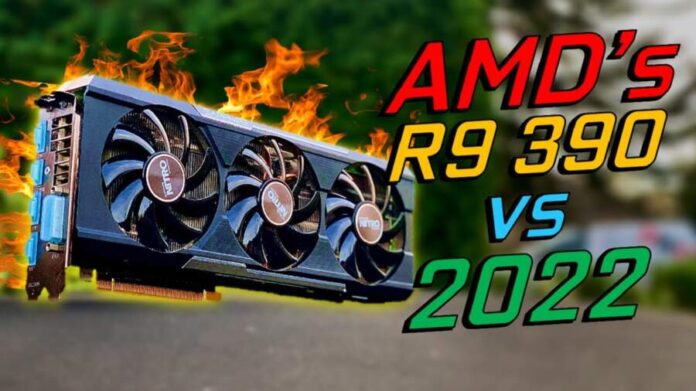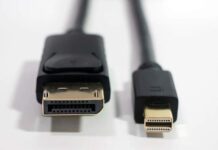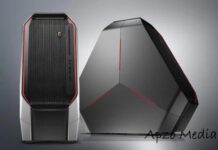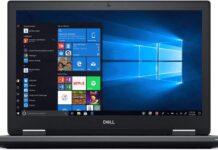AMD Radeon R9 390 is a great value for money. It runs very quietly and outperforms the competitors in terms of performance. The Tri-X cooler maintains the GPU cool, and the 8GB of memory ensures you’ll have enough for the high definition textures that will surely appear in future titles. In this article we have discussed more about this graphics card configuration and features.
AMD Radeon R9 390 Overview
The R9 390 uses the Graphics Core Next architecture, which has been used in AMD graphics cards since 2011. More specifically, the Grenada Pro core within this new card is built on the Hawaii Pro processor used in 2013’s R9 290. The R9 390 has the same design as the Hawaii XT core found within the R9 390X, but with a few changes.
The major difference is in the memory, which has been increased from 4GB to a massive 8GB on the older card. This increases the clock speed from 5,000MHz to 6,000MHz giving this one of the most powerful memory configurations seen in any card currently available.
The old card’s core clock of 947MHz has been increased to 1,000MHz. This is only 50MHz slower than the more expensive R9 390X. The card stays the same elsewhere. It has 6.2 billion transistors and 2,560 stream processors, which is only 256 less than the R9 390X.
Configuration and Specification
When compared to Nvidia’s GTX 970, all of this adds up to a respectable set of specifications. That card only has 4GB of RAM and has a 256-bit memory interface that is half the width of AMD’s new chip.
When it comes to core clock frequency, there isn’t much of a difference between the two – the GTX 970 is only 50MHz faster than the R9 390. Of course, the manner these cards are designed prevents these figures from being directly comparable.
While all of this is good news for benchmarks, there is one place where the AMD GPU is likely to fall short. In the past, the earlier architecture has struggled to compete with Nvidia in terms of heat and power consumption, and we don’t expect that to change here. This does not only imply a higher electricity bill; it also implies less flexibility when it comes to associate cards.
While the R9 390 consumes so much power that it need a huge card with a substantial cooler and power circuitry – as do other high-end graphics cards. It should be noted – the 970 is available in a compact form factor. With a length of fewer than 17cm, you can obtain the capability of that card in roughly half the space you’d think, making it excellent for designing a smaller PC.
Other than that, the R9 390 is the same. It has built-in support for Vulkan and Mantle, as well as AMD’s True Audio API and, of course, FreeSync. ZeroCore functionality is also featured, which turns the card off while the PC is inactive.
Synthetic and Gaming Benchmarks
The R9 390 is completely capable of supporting multiple monitors. However, the performance tests differ. It is can be best with a single screen with a resolution of up to 2,560 x 1,440.
At 1080p, it totally destroys all of our benchmarks, which we test at the absolute highest quality settings. Its weakest in-game average was 77 fps in Battlefield 4. And its greatest set of statistics came in Tomb Raider, with minimum and average frames per second of 116 fps and 150 fps, respectively.
Nonetheless, even at this low resolution, the AMD card’s performance credentials were proven. Its minimum Battlefield 4 frame rate of 64 fps is 8 fps faster than the 970, and its average frame rate of 77 fps is nicely between the two Nvidia GPUs.
It kept its lead over the GTX 970 in Crysis 3 and Metro: Last Light. It outperformed the Nvidia card in both realistic tasks, and even caught up to the GTX 980 in Middle-Earth: Shadow of Mordor and Tomb Raider. The AMD card maintained its amazing performance at the next higher resolution – 2,560 x 1,440.
In 3D Mark’s Fire Strike Extreme test, it was approximately 13% quicker than the 970. And it is just 3% slower than the 980. While its 52 fps average in Battlefield 4 were only three frames slower than the GTX 980 and 5 frames faster than the GTX 970.
It also outperformed the GTX 970 in BioShock with an average frame rate of 74 fps. In Crysis 3 and Metro: Last Light, the R9 390 came to life. In Crysis, its average frame rate of 50fps outperformed both Nvidia cards. While in Metro its 65 fps result was 2 frames behind GTX 980.
Benchmarks at Higher Resolution
The R9 390 doesn’t quite match our expectations for 4K gaming performance, but it’s not far off. Its BioShock average of 38 fps is hardly playable. A similar tale can be found in Batman, where the outcome of 56 fps is even nearer to our target of 60 fps.
In Metro: Last Light and Tomb Raider, AMD hardware outperformed both Nvidia cards, but fell short in simulated tests. Overall, the AMD card performed well versus Nvidia gear in 4K testing. Its overall performance seemed to be adequate. It dipped below the critical 30 fps average mark only in Battlefield 4 and Crysis 3.
The R9 390 scored incredibly well across the board. It is outperforming its main competitor in most benchmarks. And it is competing with the GTX 980 in some of the tests. It’s evident that the massive amount of RAM and its 512-bit bus. And have a greater influence on performance than the minor increase in core clock speed.
Final Verdict
The R9 390 outperformed the GTX 970 in the most of benchmarks. And even beat the GTX 980 in a few. But that performance win came at the expense of massive power consumption. And the 390 isn’t available in a small version like the GTX 970. Given the architectural similarities between the R9 390 and its larger X-branded sibling it’s no surprise that AMD’s latest card has a well-known backstory.
If you’re not too concerned about power consumption and need a card that prioritises performance. The R9 390 is the one to get. This is particularly true if you’re constructing a typical tower setup and want the future-proofing that 8GB of RAM provides. Nonetheless, Nvidia’s competitor remains a viable option for tiny, low-power devices where frame rates aren’t as important.
Also Checkout : A Step-by-Step Guide on How To Gain Instagram Followers Fast



































































